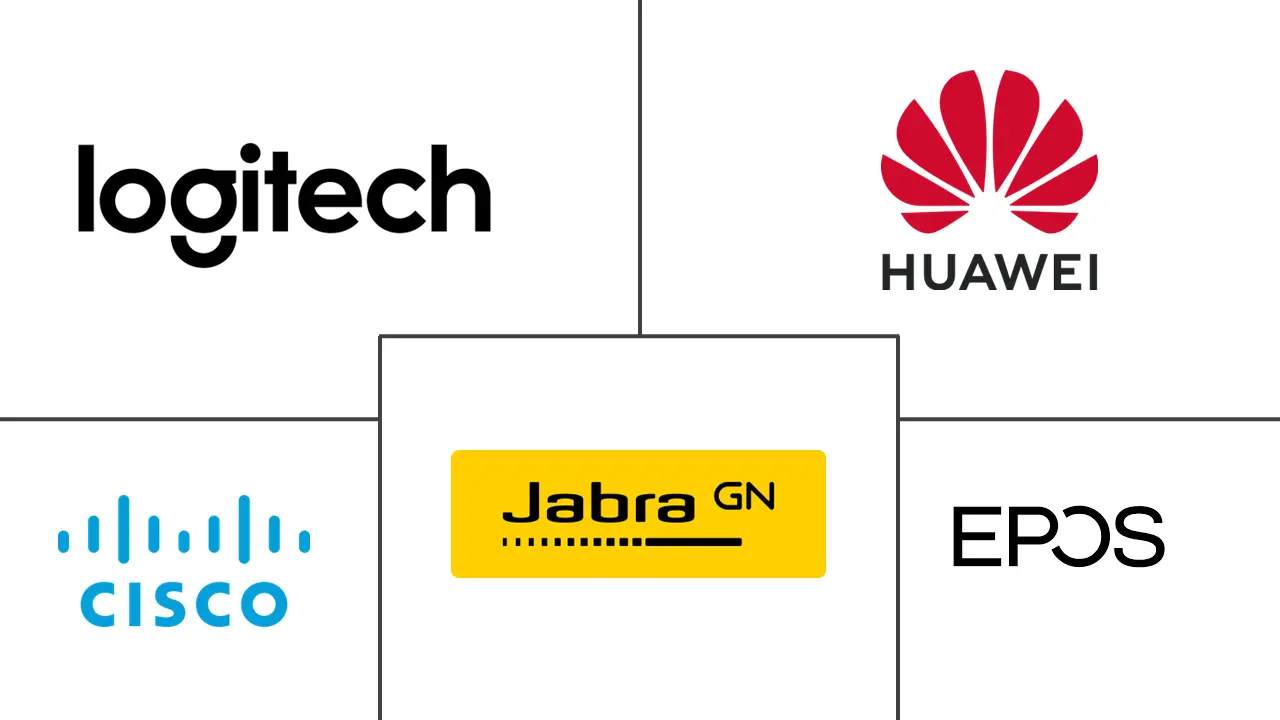North America Video Conferencing Hardware Market Size and Share
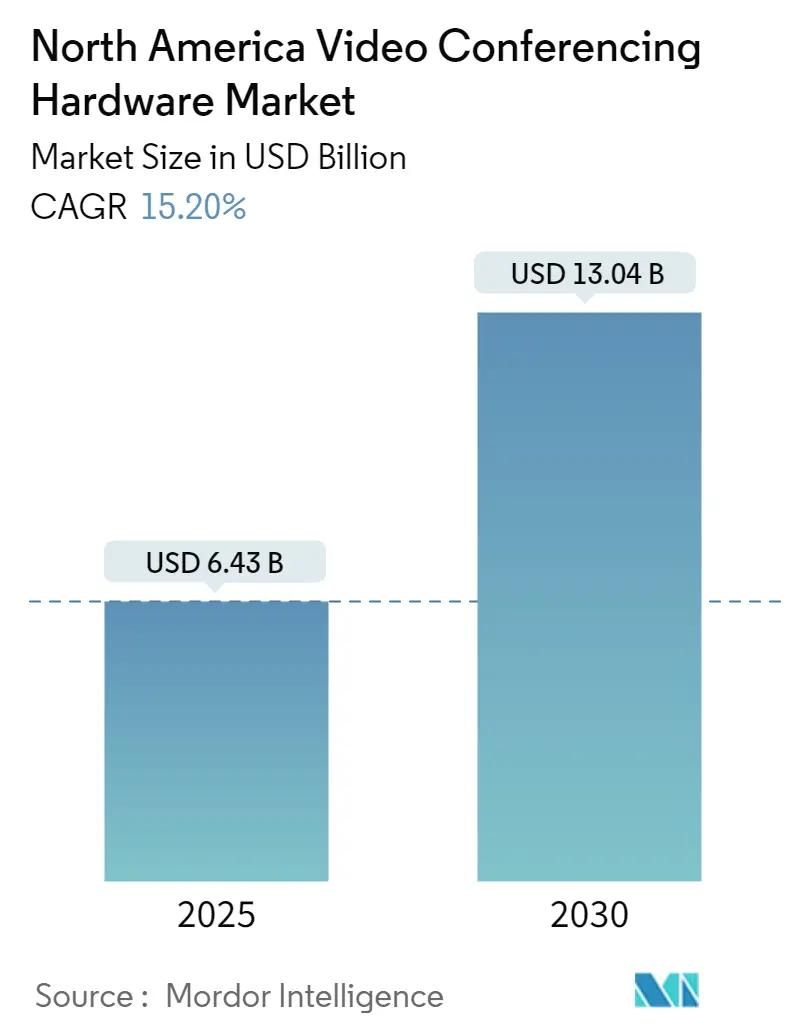
North America Video Conferencing Hardware Market Analysis by Mordor Intelligence
The North America Video Conferencing Hardware Market size is estimated at USD 6.43 billion in 2025, and is expected to reach USD 13.04 billion by 2030, at a CAGR of 15.2% during the forecast period (2025-2030).
Technological advancements in hardware such as cameras, MCUs, codec systems, enterprise headsets, and USB-based integrated bars drive the video-conferencing hardware market. The remote work or work-from-home culture of various organizations drives the demand for video conferencing hardware.
The advancement of MCUs accelerated group meetings, enabling efficient integration of inputs from various sources. MCUs ensure that each member in the video call meets the same collective feed, thus allowing efficient group communication by linking the different streams of video, audio, and data into a unified, single broadcast. Furthermore, modern MCUs integrate advanced features like transcoding that boost their potential to handle many participants with variable codec requirements bandwidth.
Cameras play a crucial role in video conferencing and remote communication in the digital world. The rising demand for remote collaboration solutions and the growth of remote work culture drive the adoption of high-resolution cameras. Prominent vendors in the camera market, such as Hikvision, Logitech, Sony, Dahua, and Huawei, are continuously investing in research and development to design innovative camera solutions with the latest technology to cater to consumer demand.
The continuous innovation and upgradation in the existing hardware create huge market opportunities. According to the Honeywell Industrial Cybersecurity USB Threat Report, in H1 2023, researchers recognized a three times rise in USB-borne malware led by two espionage campaigns that used the SNOWYDRIVE and SOGU malware variants. Both variants were spyware used to view, steal, and gain access to corporate information. To avoid such attacks, Lenovo's ThinkSmart Manager offers a USB disable option to block the USB port of conferencing devices remotely, significantly decreasing this risk and improving the device's security. Such innovations are expected to drive the market growth in the coming years.
The growth of 5G network has made it easier for people to use video-conferencing solutions, as it reduces latency and increases network speed. On the other hand, technical issues with audio/video hardware devices can limit the market growth. Low network bandwidth or connectivity issues with USB cameras/speakers/micromotes can also prevent the market from expanding. Additionally, data security issues and poor-quality audio/video or software can prevent the market from growing.
In addition, the economic slowdown and rising inflation in North America have reduced consumer spending, leading to reduced demand for video conferencing hardware and electronics products. Furthermore, the war between Russia and Ukraine hampered the global supply chain and resulted in a delay in the production of electronics products due to the unavailability of raw materials. All of these factors are likely to restrict the market growth.
North America Video Conferencing Hardware Market Trends and Insights
Institutions to Hold Significant Market Share
The institutions segment holds a significant market share owing to the large number of higher institutions, private and public institutions, and universities present in the United States. Video conferencing hardware is becoming increasingly popular in educational institutions to accelerate remote learning, online collaboration, and virtual classrooms among teachers and students. The demand for better-quality cameras, headsets, and MCUs has accelerated across higher education institutions and universities.
As Hybrid becomes the new norm, teachers must be ready to set up remote classes from anywhere, and flexible technology helps them connect to students where they teach. Furthermore, video conferencing hardware is used for live virtual classes, one-on-one meetings with teachers, group study sessions, and tutoring sessions. This helps to improve student-teacher communication and supports students' progress in their coursework.
According to Oklahoma State University, video conferences are recorded so students who cannot attend can view them later. Furthermore, as per Tennessee Tech University, a Polycom video camera is used to present a video of the instructor teaching, record in-class lectures, or livestream a class session.
With the rapid shift toward distance learning, colleges and universities are using conferencing systems to deliver online exams and courses. Furthermore, technological developments in hardware drive the adoption of video conferencing tools in institutions. Thus, key vendors are offering innovative solutions to increase market share. For example, Dahua Technology offers a DeepHub Smart Classroom Solution for digital education. This includes Dahua's hardware and software features and other products to increase interactive learning for higher education and K-12 classrooms.
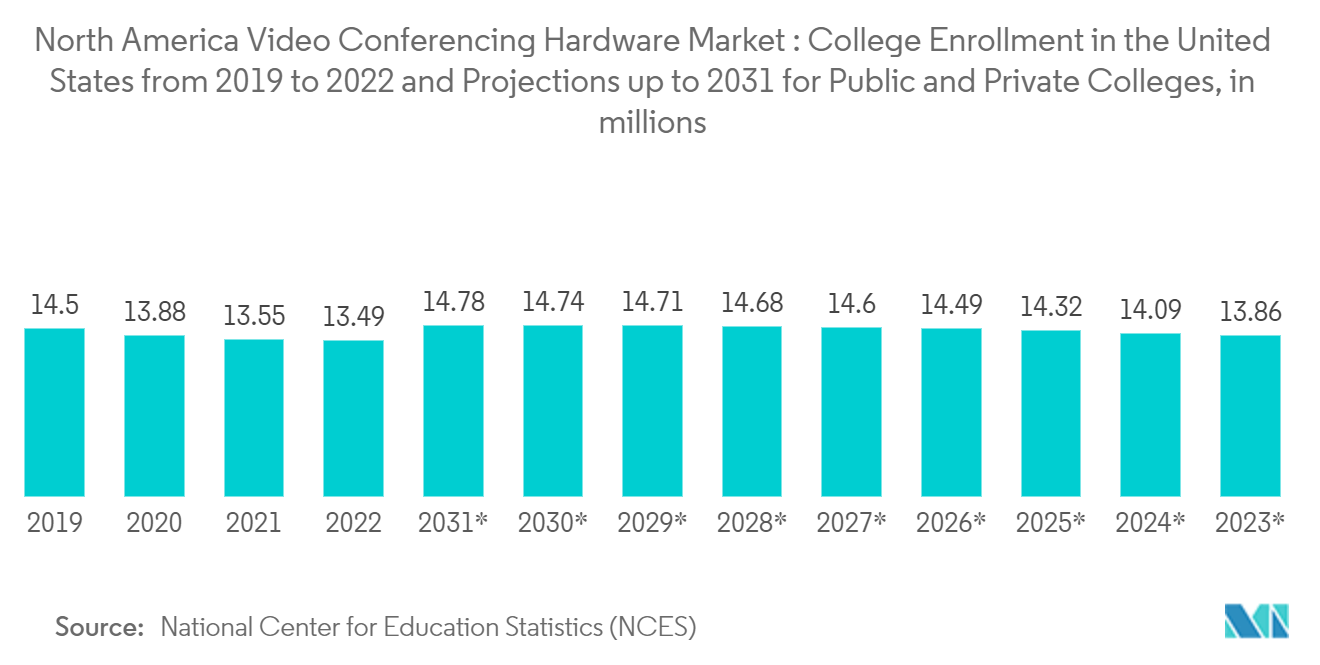
United States to Grow with a Significant CAGR
With the advent of cloud computing and other hosted technology services, there has been a surge in the use of remote working and mobile collaboration, as well as videoconferencing. With advanced tools available across a wide range of endpoints, such as mobile, room-dedicated collaboration systems, and desktops, communication is becoming lighter and more agile, bringing together the best and most important elements of collaboration regardless of the user’s location.
Video conferencing improves workforce productivity and reduces operational costs by connecting teams, customers, partners, and prospects. It also allows companies to adapt quickly to the ever-evolving virtual and mobile marketplace.
Employees now have the power to integrate video communications into their day-to-day work lives, allowing them to build deeper, more meaningful, and more effective relationships with their clients, colleagues, partners, and prospects.
As more employers allow their remote teams to have flexible schedules, there have been new trends and more options for remote work. According to Upwork, 22% of the American workforce, or 36.2 million Americans, will work remotely by 2025. According to a new Pew Research Center Organisation survey, about 35% of workers in US workplaces work from home all the time.
Moreover, 10,000 employees surveyed by the Becker-Friedman Institute for Economics at the University of Chicago, out of a total of 30% of respondents, stated they were more engaged and productive working from home. The increased remote work culture in the country creates new market opportunities.
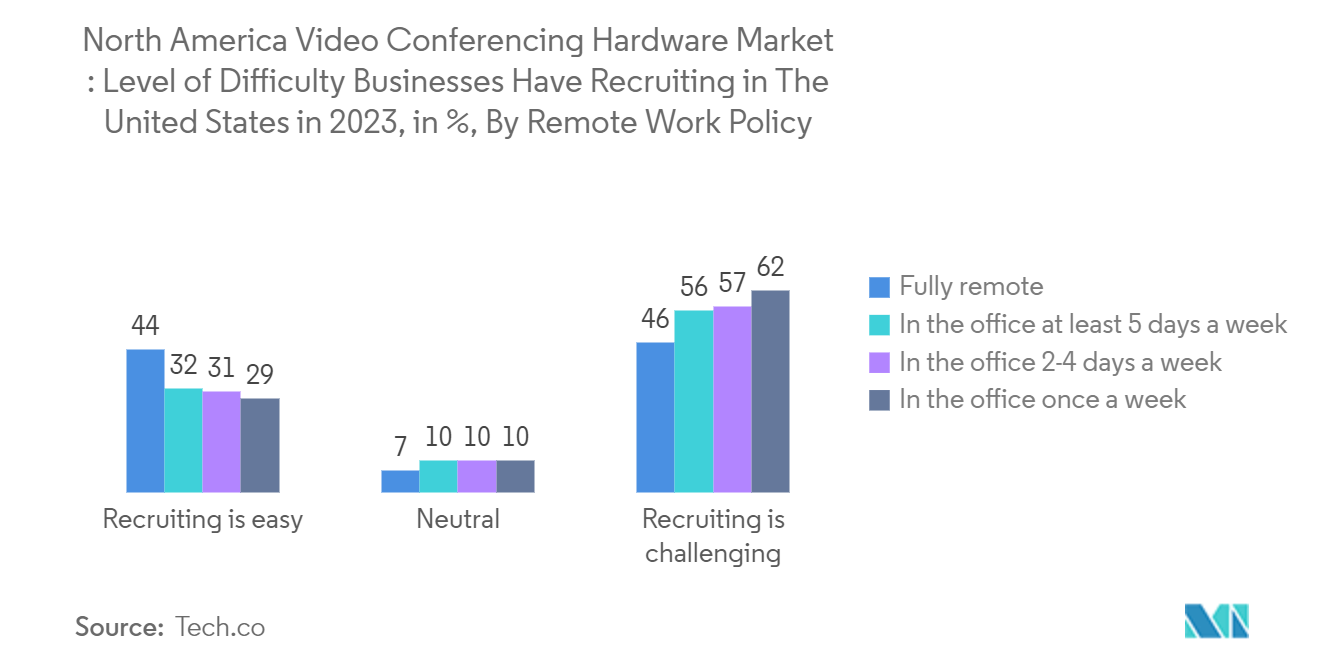
Competitive Landscape
The North American video conferencing hardware market is consolidated and dominated by a few leading vendors, such as Jabra, Poly, Cisco, Logitech, Huawei, and EPOS. Companies continuously focus on enhancing their market presence by launching new products, expanding their operations, or entering strategic mergers and acquisitions, partnerships, and collaborations.
- In March 2024, Cisco launched new, multifunctional devices that provide modernized collaboration experiences to a hybrid workforce. The new device, Cisco Board Pro G2, is a touch-enabled and AI-powered collaboration device. Cisco Desk Phone 9800 Series is designed to bring a personalized and modern productivity hub to any desk. Cisco Board Pro G2 offers optimized camera views that help improve hybrid teamwork.
- In March 2024, Logitech International launched Mevo Core, a next-generation live-streaming camera. The new 4K camera is designed for content creation and live streaming and can be controlled from a tablet or smartphone.
North America Video Conferencing Hardware Industry Leaders
-
EPOS
-
Cisco Systems Inc.
-
Huawei Technologies Co., Ltd.
-
Jabra Inc.
-
Logitech International S.A.
- *Disclaimer: Major Players sorted in no particular order
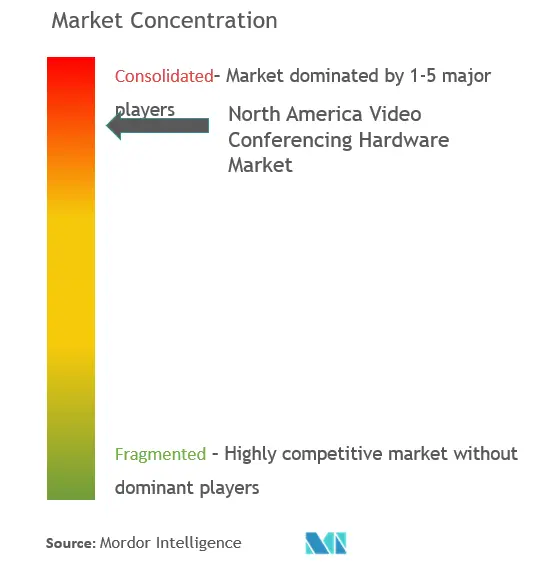
Recent Industry Developments
- February 2024 - Owl Labs Inc., a US-based video conferencing devices manufacturer, launched a new 360-degree, AI-powered video conferencing solution that includes a front-of-room camera, speaker, and microphone.
- January 2024 - Crestron Electronics, a US-based video conferencing solutions provider, launched a new AI-based PTZ camera series. 1 Beyond is designed to address the challenges of modern hybrid meetings. The 1 Beyond series includes four new cameras, each integrated with advanced optical zoom technology to preserve pixel quality and image integrity.
North America Video Conferencing Hardware Market Report Scope
Video conferencing hardware includes physical components and devices to facilitate practical video conferencing sessions. These tools capture, handle, and send video and audio signals among participants in a video conference. Essential hardware components in video conferencing systems usually consist of codecs or processors, collaboration bars, Multi-Control Units (MCU), Collaboration Bar Codec Systems, USB Cameras, USB-based Integrated Bars, and Other Packaged Kits.
The study tracks the revenue accrued through the sale of video conferencing hardware by various players in the North American market. The study also tracks the key market parameters, underlying growth influencers, and major vendors operating in the industry, which supports the market estimations and growth rates over the forecast period. The study further analyses the after-effects of COVID-19 and other macroeconomic factors on the market. The report’s scope encompasses market sizing and forecasts for the various market segments.
The North American video conferencing hardware market is segmented by product (multi-control units (MCU), collaboration bars, codec systems, USB cameras, USB-based integrated bars, other bundled kits, and enterprise headsets), end user (institutions and commercial spaces), and country (United States and Canada). The market sizes and forecasts are provided in terms of (USD) for all the above segments.
| Multi Control Units (MCU) |
| Collaboration Bars |
| Codec Systems, |
| USB Cameras |
| USB-based Integrated Bars |
| Other Bundled Kits |
| Enterprise Headsets |
| Institutions |
| Commercial Spaces |
| United States |
| Canada |
| By Type of Hardware | Multi Control Units (MCU) |
| Collaboration Bars | |
| Codec Systems, | |
| USB Cameras | |
| USB-based Integrated Bars | |
| Other Bundled Kits | |
| Enterprise Headsets | |
| By End User | Institutions |
| Commercial Spaces | |
| By Country | United States |
| Canada |
Key Questions Answered in the Report
How big is the North America Video Conferencing Hardware Market?
The North America Video Conferencing Hardware Market size is expected to reach USD 6.43 billion in 2025 and grow at a CAGR of 15.20% to reach USD 13.04 billion by 2030.
What is the current North America Video Conferencing Hardware Market size?
In 2025, the North America Video Conferencing Hardware Market size is expected to reach USD 6.43 billion.
Who are the key players in North America Video Conferencing Hardware Market?
EPOS, Cisco Systems Inc., Huawei Technologies Co., Ltd., Jabra Inc. and Logitech International S.A. are the major companies operating in the North America Video Conferencing Hardware Market.
What years does this North America Video Conferencing Hardware Market cover, and what was the market size in 2024?
In 2024, the North America Video Conferencing Hardware Market size was estimated at USD 5.45 billion. The report covers the North America Video Conferencing Hardware Market historical market size for years: 2022, 2023 and 2024. The report also forecasts the North America Video Conferencing Hardware Market size for years: 2025, 2026, 2027, 2028, 2029 and 2030.
Page last updated on:
North America Video Conferencing Hardware Market Report
Statistics for the 2025 North America Video Conferencing Hardware market share, size and revenue growth rate, created by Mordor Intelligence™ Industry Reports. North America Video Conferencing Hardware analysis includes a market forecast outlook for 2025 to 2030 and historical overview. Get a sample of this industry analysis as a free report PDF download.
